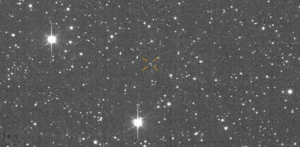China Recruits ‘Planetary Defence Force’ Amid Rising Asteroid Impact Fears
China has launched a recruitment drive for a planetary defence force to address the potential threat of asteroid 2024 YR4, which has a growing chance of impacting Earth in 2032. The initiative focuses on asteroid monitoring, international cooperation, and developing deflection technology similar to NASA’s DART mission. Experts reassure that while the risk remains low, ongoing research and preparedness are crucial.

China Recruits ‘Planetary Defence Force’ Amid Rising Asteroid Impact Fears
China has initiated a recruitment drive for a specialized “planetary defence force” following assessments that an asteroid, 2024 YR4, could pose a potential threat to Earth in 2032. The move, led by the State Administration of Science, Technology and Industry for National Defence (SASTIND), highlights China’s increasing focus on planetary defence and its growing ambitions in space exploration and security.
The recruitment advertisements, posted on Chinese social media platforms such as WeChat, call for young professionals specializing in aerospace engineering, international cooperation, and asteroid detection. The job listings indicate that China is actively expanding its planetary defence capabilities, aligning with global efforts to mitigate space threats.
Rising Concerns Over 2024 YR4
Asteroid 2024 YR4 has recently garnered significant attention from space agencies worldwide due to its increasing probability of colliding with Earth. Initially assessed at a 1.3% chance of impact, analysts have since revised that figure to 2.2%, sparking heightened discussions within the international space community. While the probability remains relatively low, the potential consequences of an asteroid impact are serious enough to warrant coordinated global action.
China is one of several nations participating in discussions with the United Nations’ Space Mission Planning Advisory Group (SMPAG), which includes space agencies from the United States, Europe, and other space-faring countries. These agencies are collectively working on strategies for monitoring, early warning systems, and deflection technologies aimed at neutralizing potential threats posed by near-Earth objects.
China’s Recruitment Efforts and Public Response
SASTIND’s recruitment drive has attracted widespread discussion online, especially among young professionals in China, where youth unemployment reached record highs in recent years. The agency posted 16 job openings, three of which are specifically for planetary defence roles. The criteria for applicants include being under 35, possessing a master’s degree or higher in astrophysics, aerospace science, or Earth and space exploration technology, and demonstrating political alignment with the ruling Communist Party.
The job postings have sparked both serious debate and humor on Chinese social media platforms. Some users joked about the immense responsibility the recruits would bear, while others highlighted the heroic nature of the role. A widely shared comment on Weibo remarked, “If you succeed, you’re a hero who saves the world. But if you fail… well, no one would be left to blame you.”
China’s Expanding Planetary Defence Program
China has been steadily advancing its space defence initiatives, including research into asteroid impact mitigation strategies. The country is actively developing its own planetary defence systems, drawing inspiration from NASA’s successful 2020 Double Asteroid Redirection Test (DART) mission.
DART marked the first time humanity intentionally altered the trajectory of an asteroid by crashing a spacecraft into Dimorphos, a 160-meter-long asteroid. The experiment demonstrated the feasibility of using kinetic impactors to redirect potentially hazardous asteroids. Following NASA’s success, the European Space Agency (ESA) launched a secondary mission to study the long-term effects of the impact.
In a similar effort, China is planning its own asteroid deflection test, scheduled for 2027. The mission will target a smaller asteroid, 2015 XF261, in an attempt to validate its capability to change an asteroid’s course. However, experts, including planetary scientist Harrison Agrusa from the Observatoire de la Côte d’Azur, have expressed concerns that attempting to disrupt a smaller asteroid could lead to fragmentation, potentially creating multiple unpredictable projectiles instead of a single deflected object.
The Global Effort in Planetary Defence
China’s latest recruitment and research efforts align with broader international initiatives aimed at strengthening planetary defence. Countries and space agencies worldwide are investing in monitoring and mitigation technologies, recognizing that while the risk of asteroid impact is low, preparedness is essential.
NASA, ESA, and other agencies have been working on more advanced asteroid detection and tracking systems, including the Near-Earth Object Surveyor (NEO Surveyor) mission, designed to identify hazardous asteroids well in advance. The collaboration among international space programs underscores the growing recognition of planetary defence as a critical aspect of space exploration.
Managing the Risk: Science Over Fear
While the growing probability of 2024 YR4’s impact has raised concerns, scientists emphasize that such threats can be managed through continued research and technological advancements. The lessons learned from the DART mission provide confidence that deflection techniques can be refined and deployed effectively if necessary.
Harrison Agrusa reassures that fear should not be the primary response to asteroid threats. “We know we have the capability to deflect an asteroid like this, as demonstrated by the Dart mission. So this asteroid doesn’t need to be feared, it just needs to be studied and understood.”
Conclusion
China’s recruitment of a planetary defence force reflects a proactive approach to addressing potential asteroid threats while bolstering its aerospace sector. The move aligns with international space efforts and demonstrates China’s commitment to advancing planetary defence technologies.
As research continues, global cooperation will be crucial in mitigating risks posed by near-Earth objects. While 2024 YR4 currently remains a low-probability threat, continued vigilance, scientific exploration, and technological innovation will ensure that humanity is prepared for any future challenges from space.
Check out TimesWordle.com for all the latest news
You must be logged in to post a comment.